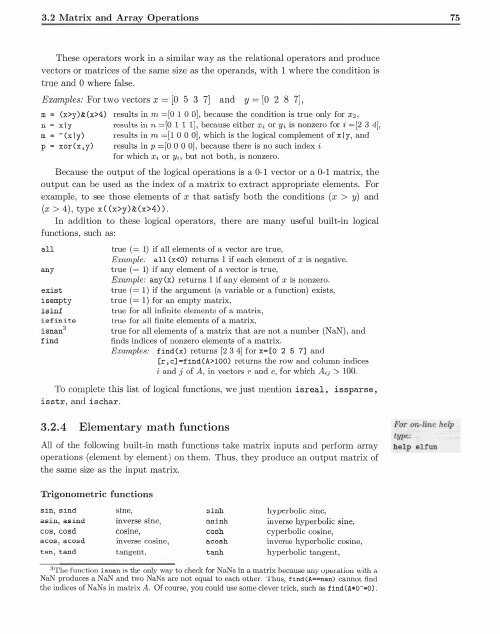Create successful ePaper yourself
Turn your PDF publications into a flip-book with our unique Google optimized e-Paper software.
3.2 Matrix and Array Operations<br />
75<br />
These operators work in a similar way as the relational operators and produce<br />
vectors or matrices of the same size as the operands, with 1 where the condition is<br />
true and 0 where false.<br />
Examples: For two vectors x = [0 5 3 7] and y = [0 2 8 7] ,<br />
m = (x>y)& (x>4)<br />
n x \ y<br />
m = -cx\y)<br />
p = xor(x,y)<br />
results in m =[0 1 0 OJ , because the condition is true only for x2 ,<br />
results in n =[0 1 1 1], because either Xi or Yi is nonzero for i = (2 3 4],<br />
results in m =[1 0 0 OJ, which is the logical complement of x I y, and<br />
result:; in p =[0 0 0 0] , because there is no such index i<br />
for which x, or yi , but not both, is nonzero.<br />
Because the output of the logical operations is a 0-1 vector or a 0-1 matrix, the<br />
output can be used as the index of a matrix to extract appropriate elements. For<br />
example, to see those elements of x that satisfy both the conditions (x > y) and<br />
(x > 4), type x( (x>y)& (x>4) ).<br />
In addition to these logical operators, there are many useful built-in logical<br />
functions, such as:<br />
all<br />
any<br />
exist<br />
is empty<br />
isinf<br />
isfinitQ<br />
isnan 3<br />
find<br />
true ( = 1) if all elements of a vector are true,<br />
Example: all (xlOO) returns the row and column indices<br />
i and j of A, in vectors r and c, for which Aii > 100.<br />
To complete this list of logical functions, we just mention isreal , is sparse ,<br />
isstr, and ischar.<br />
3.2.4 Elementary math functions<br />
All of the following built-in math functions take matrix inputs and perform array<br />
operations (element <strong>by</strong> element) on them. Thus, they produce an output matrix of<br />
the same size as the input matrix.<br />
Fo r on-line help<br />
type:<br />
help elfun<br />
Trigonometric functions<br />
sin, sind<br />
asin, asind<br />
cos, cosd<br />
acos , acosd<br />
tan, tand<br />
sine,<br />
inverse sine,<br />
cosine,<br />
inverse cosine,<br />
tangent ,<br />
sinh<br />
a sinh<br />
cosh<br />
a cosh<br />
tanh<br />
hyperbolic :sine,<br />
inverse hyperbolic sine,<br />
cyperbolic cosine,<br />
inverse hyperbolic cosine,<br />
hyperbolic tangent,<br />
3The function isnan is the only way to check for NaNs in a matrix because any uveralion with a<br />
NaN produces a NaN and two NaNs are not equal to each other. Thus, find(A==nan) cannot find<br />
the indices of NaNs in matrix A. Of course, you could use some clever trick, such as find (A*0-=0) .



